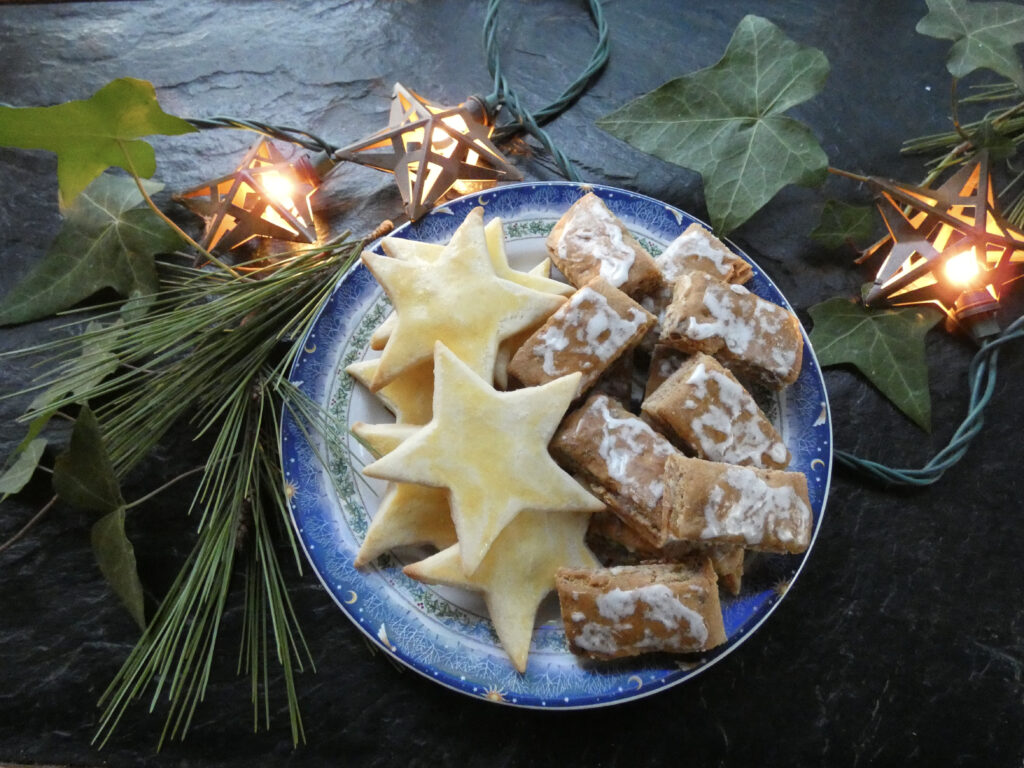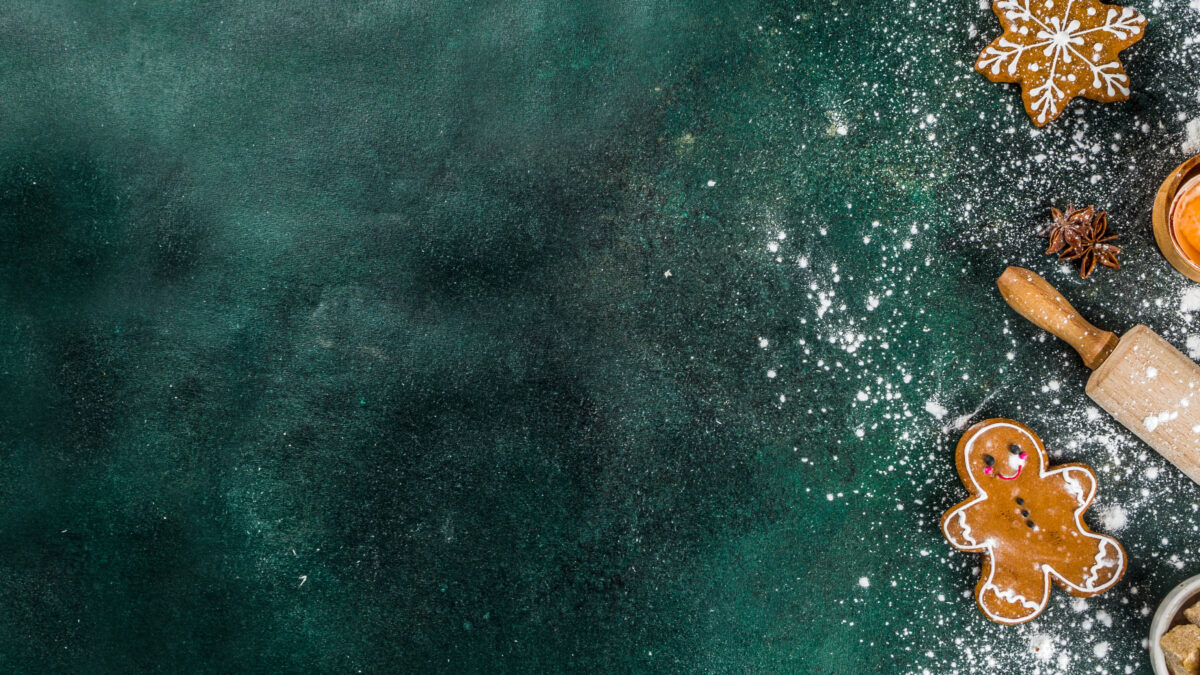
We’re celebrating the holidays with some favorite family recipes here at TNT this year. Chloe Chapman has brewed up her own special homemade spiced apple cider recipe, which embodies the scent and flavor of the holidays. Suzanne Guldimann shares two much-loved family recipes for traditional and delicious cookies from Switzerland. Happy holidays to all of our readers from the whole crew at TNT!
Homemade Apple Cider by Chloe Chapman
There are many things we associate with the holiday season; gift giving, family, and snow, to name a few. Each year, we celebrate the holidays with age-old traditions that are comforting, nostalgic, and familiar to us. Whether we realize it or not, every year we celebrate these special days in December with all five of our senses. We put up decorations outside, and inside our houses to create a joyful celebration for our eyes to see. We use our arms to hug and hold friends and family members close, using touch—something we’ve gained an even greater appreciation for over the past couple of years. We listen to traditional Christmas, or Hanukkah Songs to create that familiar, nostalgic feel from past years.
As for smell and taste, everyone has different signature foods or scents that mean a lot to them this time of year, but I wanted to share a recipe that covers both of those last senses, fabulously.
Homemade Apple Cider
9 or 10 apples, quartered (any kind, I used pink ladies and granny smiths)
1 or 2 oranges, quartered (I did not peel them, but if you want a less-tart cider you can)
1 – 1 ½ tablespoons cinnamon (or 3 cinnamon sticks) *
1 teaspoon ground ginger *
1 teaspoon nutmeg *
1 tablespoon whole cloves *
12 or 13 cups water
½ – ¾ cup maple syrup, or sweetener of choice
You will need a large pot and hours to spare! Place the cut-up fruit into the pot, and top with the spices (*NOTE: you can substitute any or all spices with a pumpkin spice seasoning mix, or allspice). Cover with water, leaving about 2 inches of empty space above the mixture.
Heat cider until simmering, then reduce to low heat and simmer with the lid on the pot for 2 hours. Let the signature holiday scent fill your house and warm your soul. When your timer goes off, check to make sure the fruit is soft, and then mash all the pieces against the side of the pot with a wooden spoon (or potato masher, if you have one) to get all the flavor out, until your cider looks a bit like applesauce.
Put the lid back on, and simmer the mash for another hour. Then strain the cider with a fine-mesh strainer or cheesecloth. When you have squeezed all the liquid into a container of your choosing, compost the solid mash. Stir in the maple syrup (or other sweetener) a little at a time—to taste.
Then enjoy your special holiday treat! Best served warm 🙂
Swiss Cookies by Suzanne Guldimann

Winter is long in Switzerland and Christmas lasts from Christmas Eve to Epiphany, January 6, offering a little joy and warmth at the darkest and coldest time of the year.
Cookies are an essential part of a Swiss Christmas. My Swiss-born father loved Mailänderli, a butter cookie that is a Swiss holiday tradition, and we always made them together.
The name means “little cookie from Milan,” but this much loved holiday treat appears to have originated in the German-speaking part of the country in the 18th century. Today, it is so much a part of Christmas in Switzerland that shops sell the dough ready to be rolled out and cut into shapes and baked at home.
My father always made these cookies with the juice and zest of the Meyer lemons he grew in our garden—a California twist on the old recipe that has become a family tradition. Kirsch, a clear, strong brandy made from cherries, imparts a beautiful fragrance and adds a uniquely Swiss flavor to this recipe, but it isn’t always easy to find. Calvados—French apple brandy—is a good substitute, so is apple juice, or more lemon juice for a more tart but still tasty cookie.
These cookies are traditionally cut into star shapes and glazed with egg yolk, but a simple lemon and powdered sugar glaze works well, too.
Mailänderli (also called Suisse Romande, and Milanais, or Milanesini)
3 cups of flour
3/4 cup sugar
1/2 cup of butter or margarine (one stick)
2 whole eggs, plus one yolk (for the glaze)
The grated zest of a lemon and its juice
1 tablespoon of kirsch
Cream the butter, add the sugar, lemon zest and juice, and kirsch. Gradually add the flour. The dough should be smooth but still fairly sticky.
Refrigerate for at least four hours. Overnight is better. Roll out to about a quarter inch thickness on a floured surface and cut out into shapes. Stars are traditional. Glaze with the egg yolk, and bake for 10-12 minutes in a 350 degree oven. The cookies should be an even light golden. Remove from the oven before the edges brown.
Mailänderli are good right out of the oven, but taste even better after the cookies have “rested” for a few days. They also store well.
Basler Läkerli is another classic Swiss cookie. It’s a medieval variety of Lebkuchen that originated in Basel, an important trade city near the border with Germany, where this cookie is also popular. Basel had a thriving spice market in the fifteenth century, when this treat first became a local specialty—the word läckerli means “little delicious morsel.” The recipe has survived mostly unchanged for centuries.
This is an unusual recipe. The key is to prepare all of the ingredients in advance and work the dough while it’s still warm, or it will turn into an excellent if expensive concrete substitute. Läckerli doesn’t provide instant gratification—it needs to be stored for several days to a week in an airtight container before it’s soft enough to eat—but it also keeps for weeks or even months, and it offers a little taste of history.
This is a rare cookie recipe that doesn’t call for eggs, or any rising agent. For vegans who prefer not to use honey, agave syrup can be used as a substitute. Adding a few drops of orange water helps to recreate the floral element of the honey.
Basler Läkerli
4-5 cups of flour
2 cups honey
1/2 cup kirsch
1/2 cup sugar
1/2 cup candied orange peel & 1/2 cup candied lemon peel
1 cup almonds & 1 cup hazelnuts
The zest and juice of one or two lemons
1 tablespoon cinnamon
1 teaspoon ground cloves
Prepare everything in advance and have it ready to go. Chop the candied peel and the nuts. If you use a food processor, mix a little flour into the fruit to prevent it from clumping and do the hazelnuts separately—that round shape makes it harder to chop them up evenly. The texture should be fairly coarse, but without big chunks. Candied orange peel can be doubled and the lemon peel omitted if needed. It’s usually easier to find orange peel than lemon peel, and it is more likely to be available in an organic version.
Boil the honey in a large pot—boiling hot honey is scary, and everything is going to go into this pot, so it needs to be big.
Turn the temperature down and add the kirsch—be careful, if the honey is too hot, it may erupt momentarily like a small volcano. Add the sugar and stir until the granules dissolve. Take the pot off the stove, and stir in everything except the flour.
Add the flour a little at a time, reserve the fifth cup for kneading and rolling out. Stir each addition in with a sturdy spoon. The first two cups are easy, but by time the third cup goes in the dough will begin to be stiff. It may be easier to knead the fourth cup in by hand. Transfer the dough to your rolling surface that is covered with a sheet of baking parchment and liberally dusted with flour. Before starting to knead or roll the dough, take a moment to soak the pot and any utensils that have come into contact with it—this stuff is almost impossible to remove when it sets up.
Once the dough is smooth and the fourth cup of flour has been fully worked in, roll it out to about 1/2 inch thickness. Or spare yourself the stickiness, and press it directly into a pan that is lined with parchment paper.
The traditional shape is small rectangles. I like to score the dough before I put it in the oven. If it isn’t scored, it needs to be pricked with a fork to vent the steam.
Bake at 350 for 20-25 minutes and keep a careful eye on it. The cookies should be pale gold. Do not overcook! If they cook too long they will be too hard to eat.
The traditional glaze is made with raw egg whites and powdered sugar, brushed on hot. I prefer to use lemon juice, a dash of kirsch, and powdered sugar to make an egg-free glaze. Brushed on when the cookies are still warm, it gives a similar finish without the eggs. Before removing the cookies from the pan, use a metal spatula or a cleaver to cut the sheet into small rectangles, about one inch by two. If you scored it before baking this is easy, if not it may take some muscle.
Pack the cookies away in containers once they are cool and let them sit for several days or more to “cure.” Don’t be dismayed if the texture at first resembles roofing tiles. The honey will pull moisture out of the air and soften the cookies, unless they were overcooked, in which case they are now ideal building materials for a gingerbread house.
Läckerli cookies last for months, travel well, and go beautifully with a cup of coffee at Christmas or any time of the year (and if you went to the trouble of tracking down a bottle of kirsch for this recipe, you could add a tablespoon or two to the coffee). Schöni Wiehnachte!













